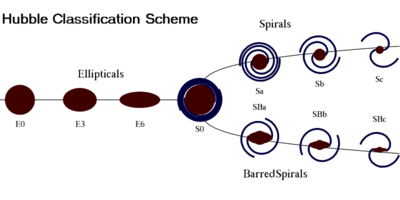Galaxies are classified according to a scheme developed by E.P. Hubble as shown on diagram below.

The tuning-fork diagram
Galaxies are divided in 5 types and for each type there is a specific classification system.
Elliptical galaxies (E0-7)
The number indicates the degree of eccentricity (as it appears in the sky) with E0 for those perfectly round to E7 for those which are flattened.
Elliptical galaxies are made of old and rich stars.
These galaxies have various masses. The elliptic dwarfs ones are the smallest of galaxies, with approximately 1 million solar masses. To the other extreme, the elliptic giants are the largest galaxies known with ten thousand billion solar masses, the equivalent of 100 average spiral galaxies.
14% of the galaxies are elliptic.

M89 - elliptical galaxy of class E0 in Virgo constellation

NGC 4697 - elliptical galaxy of class E6 in the Virgo constellation
Lenticular galaxies (S0 and SB0)
The lenticular galaxies have disk like shape similar to spiral galaxies, but they have neither arms nor structure. They are similar to the elliptic galaxies for their uniform stellar density in the disc and the age of these stars is almost as old as those in elliptic galaxies.
13% of the galaxies are lenticular.

M 102 - Lenticular galaxy of class SA0 in the Dragon constellation
Spiral galaxies (Sa-d)
Sa to Sd refer to how 'tightly wound' these arms are (from very tight to very loose).
Spiral galaxies have the shape of a flattened disc. They are characterized by two or more arms made up of young stars that are around a bulge of old stars.
The standard mass of a spiral galaxy is about 100 billion solar masses.
70% of galaxies are spiral galaxies.
Barred spiral galaxies (SBa-d)
Barred spiral galaxies differs from spiral galaxies in that spiral galaxies have arms which leave directly the core whereas barred spiral galaxies have an oval shaped bulge with a transverse bar from which ends the arms are projected out.
Intermediate spiral galaxies (SAB) have a form that is between regular spiral galaxies and barred spiral galaxies.
The subclasses "has", "B", "C" and "D" qualify the relative importance of the core (decreasing of "A" with "D"), and the degree of rolling up of the arms (of "the A" tightest with "the D" loosest).
The presence of two subclasses in the classification of a galaxy, for example SAab, indicates an intermediate form between these two subclasses.
The Magellanic Cloud galaxies were once classified as irregular galaxies, but have since been found to contain barred spiral structures. They have then been re-classified as 'SBm', a 4th type of barred spiral galaxy.

M64 - Black Eye Galaxy of class SAab Hair's Berenice constellation

M91 - Barred spiral galaxy barred of class SBb in Hair's Berenice

M83 - Southern Pinwheel Galaxy (SABc) in the Hydra constellation
Irregular galaxies
They are made of 10 to 20% of gas.
These galaxies are generally rather not very massive, a few billion solar masses only (from 10 to 100 times less than a standard spiral galaxy).
3% of the galaxies are irregular.
The irregular galaxies are divided into 2 major Hubble types:
Irr I (with some structure) and Irr II (without any structure).

IC 5152 - Dwarf irregular galaxy of class IAm

ESO 056-G115 - Galaxy of the Large Magellanic Cloud (SBm)
The 'p' or 'pec' indications, at the end of the classification of a galaxy, means 'peculiar' to give an account of an abnormal form generally caused by galaxy interaction or the collision.
Other deep sky objects:
Globular clusters
Open clusters
Planetary nebulae
Home








